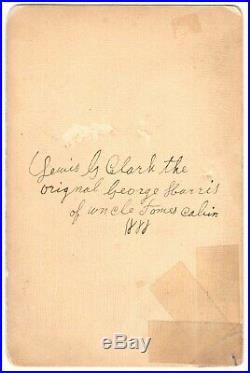SLAVE & ABOLITIONIST LEWIS CLARK original cabinet photo 1888 African American



SLAVE & ABOLITIONIST LEWIS CLARK. Lewis Clarke's autobiography, Narrative of the Sufferings of Lewis Clarke was published in 1845. Clarkes autobiography begins with his birth in 1815 in Kentucky and continues through the early 1840s when he was living in Cambridge, Massachusetts.
The Narrative described what he endured as the child of a Scottish father and a quadroon mother who was a slave on his Madison County, Kentucky plantation. It was at this point that Clarke decided to escape from bondage and seek refuge in Canada where he assumed his brother Milton had escaped months earlier. Lewis connected with Milton in Oberlin, but soon decided to bring his youngest brother, Cyrus, out of slavery in Lexington, Kentucky. His Narrative describes how he and Milton were nearly captured by slave hunters in Oberlin before they escaped to Massachusetts.
Clarkes exploits as an escaped slave were also described in newspaper articles in Ohio as well as word of mouth by anti-slavery abolitionists throughout the state. Abolitionist leaders in the Northeast became aware of him and as a result he was enticed to come to Cambridge, Massachusetts with plans to bolster the abolitionist movement in that state. While in Cambridge, Clarke lived several years in the home of Mary Jackson Safford, the sister-in-law of Harriet Beecher Stowe. Harriet Beecher Stowe met Clarke, interviewed him on many occasions, and took detailed notes regarding his experiences as a slave. Stowe's Book Uncle Toms Cabin, was published in 1852.Stowe's second book The Key to Uncle Toms Cabin was published one year later in which Stowe tells of Clarke's experiences as a slave and verified that the character George Harris of her book was based upon Clarkes early life. Clarkes many lectures and the publication of his Narrative made him a popular figure in the Northeast. He shared speaking platforms with the leading abolitionists of the era including his relative by marriage, Frederick Douglass. By the late 1840s he moved to the Underground Railroad town of Busti in southwestern New York State.
While there he became the vigilante protector of escaped slaves from the South. He continued his lectures across the Northern United States as well as Canada.By the mid-1850s Clarke was held in such high esteem that he was invited to deliver one of the keynote addresses at the founding convention of the Republican Party in Jackson, Michigan in July 1854. The passage of the Fugitive Slave Law of 1850 allowed slave owners and their surrogates to seek out and capture escaped slaves anywhere in the United States. The new law gave Clarkes owners in Kentucky greater incentive to capture him.
He narrowly escaped slave catchers who came to Busti seeking him out in the early 1850s. The close call made him decide to move to Ontario, Canada. Subsequently he married Emily R. Walker, originally from Lexington, Kentucky, and had nine children with his new wife. Clarke also became a successful farmer and not surprisingly, his property became a haven for escaped slaves from the United States.
Clarke continued on the lecture circuit speaking on his experiences as a slave and reminding the crowds that George Harris of Uncle Toms Cabin was based upon his life. He also became a labor broker between Southern planters who needed labor and former slaves in Canada who sought work in the post-Civil War South.
In the mid-1890s a controversy arose between Clarke and Harriet Beecher Stowe regarding his role as one of the models for Uncle Toms Cabin. Clarke continued to claim that he was a long time acquaintance of Mrs. Stowe and that she would not have been able to write her book without the information she had received from him. As Stowe's life ebbed away, however, she and her family denied any knowledge of him. Her denial came a year before she died and six years into her severe case of dementia.
He died in 1897 at the age of 82. In addition to being laid in state in the Lexington City Auditorium, he was eulogized by newspapers around the country. PHOTOGRAPHER: New York Gallery, Detroit, MI.PHOTO CONDITION: good condition, excellent clarity and contrast. Mount has old mend on reverse bottom right corner (does not affect front image).
ID: verso signature Lewis G Clark the original George Harris of Uncle Tom's Cabin 1888 (Harriet Beecher Stowe interviewed Lewis Clark and used his life events for the character of George Harris in her book Uncle Tom's Cabin). DIMENSIONS: 6.5 x 4.25 inches. WATERMARK: fly'n figs will not appear on actual photo. BOOK: Lewis Clark Biography When Owing a Shilling Costs a Dollar, by great grandson of Lewis Clark is included. The item "SLAVE & ABOLITIONIST LEWIS CLARK original cabinet photo 1888 African American" is in sale since Monday, March 23, 2020.This item is in the category "Collectibles\Photographic Images\Vintage & Antique (Pre-1940)\Cabinet Photos". The seller is "ktwayne" and is located in Milton, Florida. This item can be shipped to United States.
- Region of Origin: US
- Modified Item: No
- Country/Region of Manufacture: United States
- Size Type/Largest Dimension: Medium (Up to 10")
- Listed By: Dealer or Reseller
- Date of Creation: 1890-1899
- Color: Sepia
- Photo Type: Cabinet Photo
- Subject: Ethnic
- Original/Reprint: Original Print
